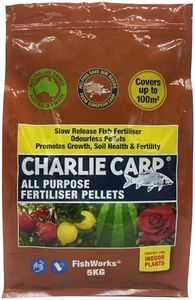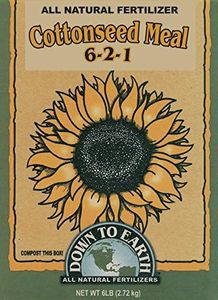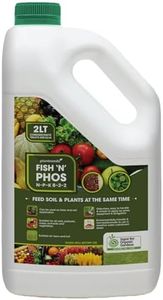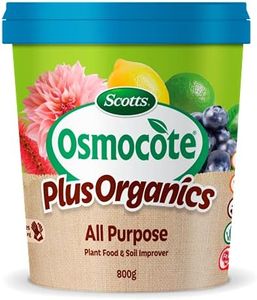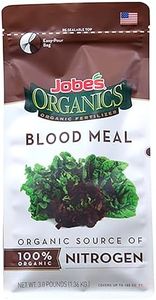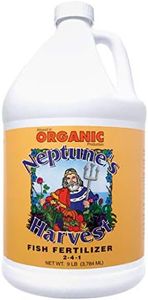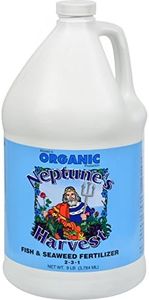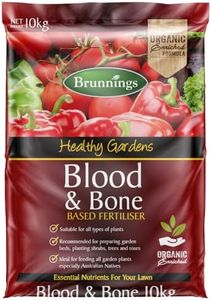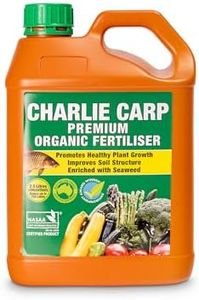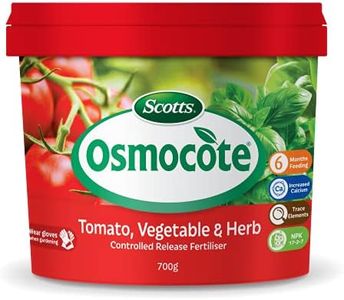We Use CookiesWe use cookies to enhance the security, performance,
functionality and for analytical and promotional activities. By continuing to browse this site you
are agreeing to our privacy policy
10 Best Vegetable Garden Fertilizers
From leading brands and best sellers available on the web.Buying Guide for the Best Vegetable Garden Fertilizers
Choosing the right fertilizer for your vegetable garden is crucial for healthy plant growth and a bountiful harvest. Fertilizers provide essential nutrients that plants need to develop strong roots, lush foliage, and productive yields. The ideal fertilizer depends on your soil's condition, the types of vegetables you’re growing, and your gardening style. Understanding key fertilizer specifications will help you make the best choice tailored to your garden’s needs.N-P-K RatioThe N-P-K ratio represents the balance of nitrogen (N), phosphorus (P), and potassium (K) in the fertilizer. Nitrogen supports leafy growth, phosphorus is essential for root and fruit development, and potassium helps overall plant health and resistance. Fertilizers are usually labeled with three numbers, like 10-10-10, reflecting their percentage of N, P, and K. If your plants have lots of leaves but few fruits, you might need more phosphorus; for lush greens, look for higher nitrogen. Think about what your vegetables need: leafy greens, like lettuce, prefer more nitrogen, while fruiting plants, like tomatoes, benefit from higher phosphorus and potassium. Match the ratio to your crop’s life stage and needs.
Release Type (Slow-Release vs. Quick-Release)Fertilizers come in slow-release and quick-release forms. Quick-release fertilizers supply nutrients immediately, ideal for a rapid boost, but they may require more frequent applications. Slow-release fertilizers feed plants gradually over weeks or months, reducing the risk of over-fertilization and saving you time. If you want steady, low-maintenance nutrition, choose slow-release types. If you need to correct a deficiency fast or kickstart early growth, a quick-release option might be helpful. Your gardening schedule and desire for hands-on care can guide your choice here.
Organic vs. SyntheticOrganic fertilizers are made from natural materials like compost, manure, or bone meal. They improve soil structure and encourage beneficial microorganisms, but they often release nutrients slowly. Synthetics are manufactured chemicals that provide immediate, precise nutrition but don’t improve the soil long-term. If you value natural gardening and enriching your soil, go organic. If you want a targeted, quick nutrient boost, synthetic may be suitable. Consider environmental impact and your gardening philosophy when deciding between these two.
Micronutrient ContentBesides the main nutrients (N-P-K), plants need small amounts of micronutrients like calcium, magnesium, zinc, and iron. Some fertilizers add these extras, which are important for preventing deficiencies and keeping plants healthy. If your garden soil is poor or you notice unusual leaf spots or stunted growth, a fertilizer with added micronutrients can help. For most gardens with compost and variety, micronutrient needs are met, but specific crops or problem soils might need extra attention.
Form (Granular vs. Liquid)Fertilizers come as granules, powders, or liquids. Granular fertilizers are sprinkled around plants or mixed into soil and release nutrients slowly. Liquids act quickly and are often mixed with water for watering. Granules suit gardeners who prefer less frequent applications, while liquids fit those who want to fine-tune feeding or give a fast boost. Choose the form based on how often you garden, how precise you want feeding to be, and the ease of application you prefer.


